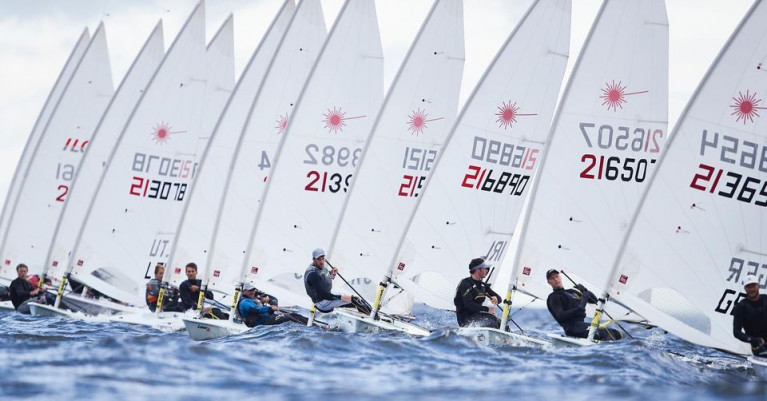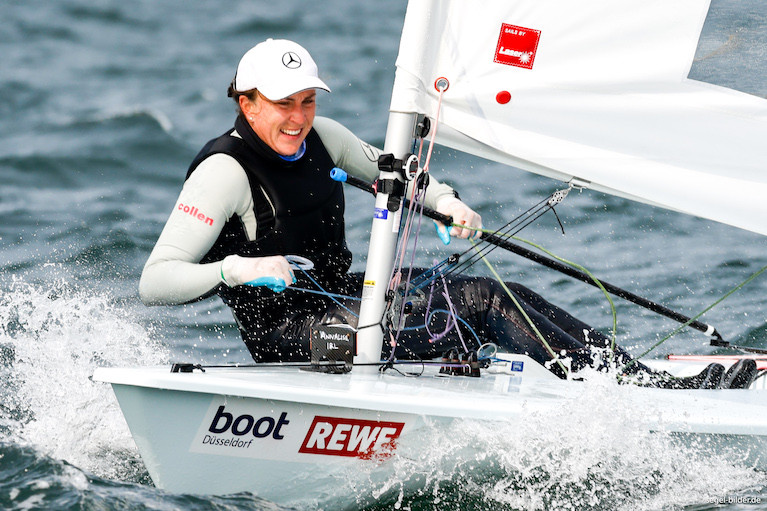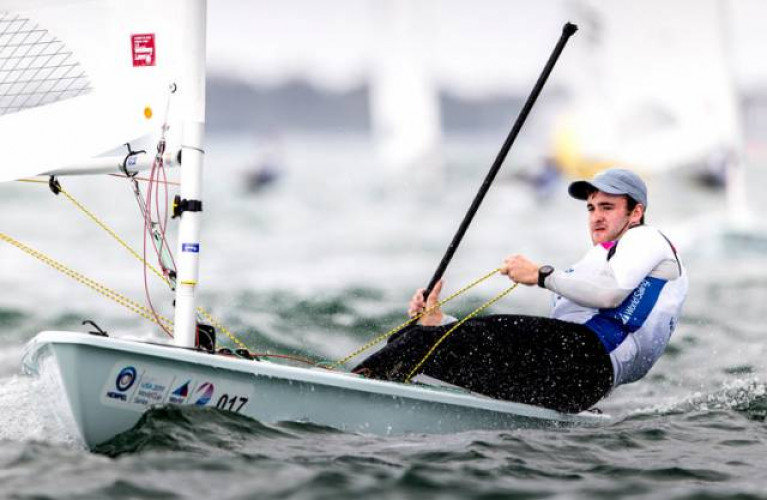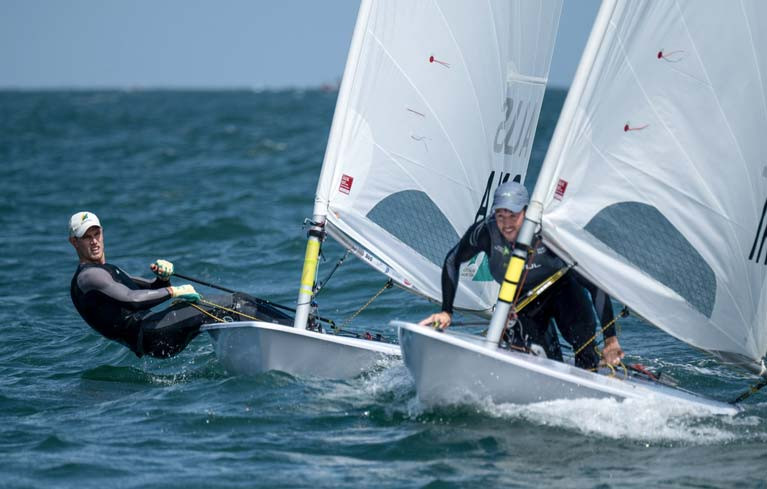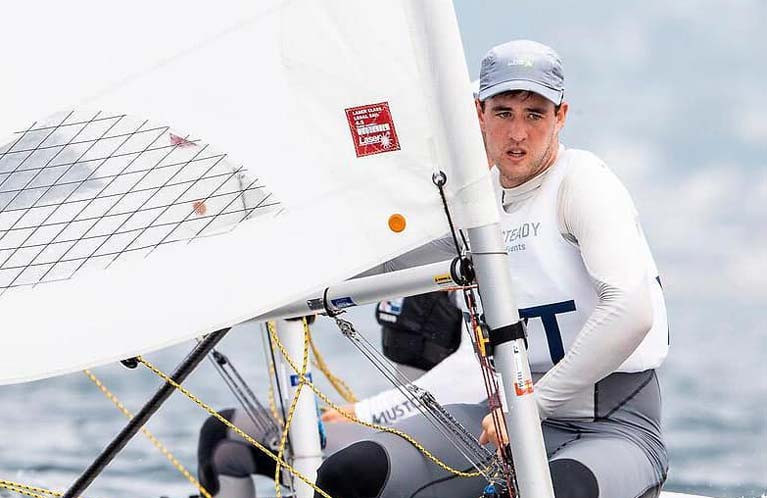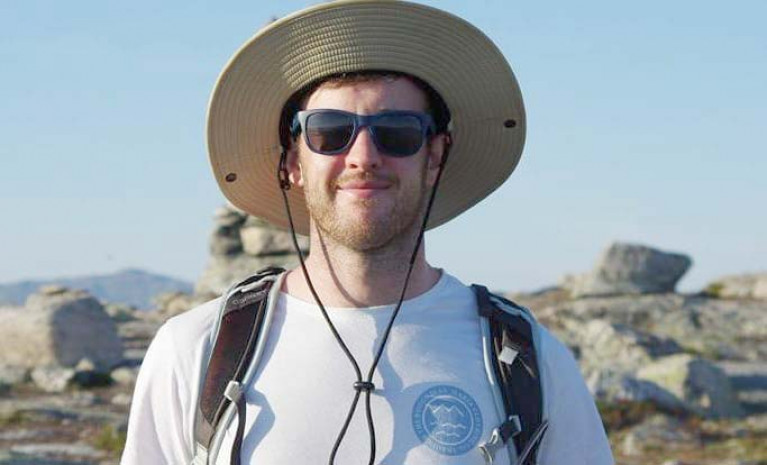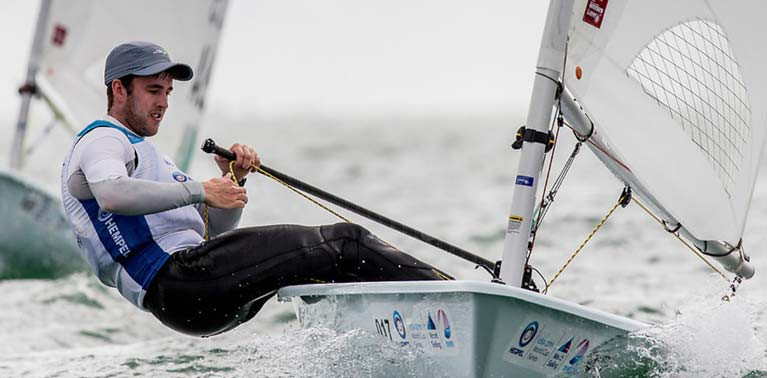Displaying items by tag: Finn Lynch
Finn Lynch 42nd After Four Races of Laser Euros in Poland
The National Yacht Club's Finn Lynch has dropped five places to be 42nd overall after four races sailed at the 126-boat fleet of the Men's Laser Radial European Championships on Gdansk Bay in Poland.
Belfast Lough's Liam Glynn is six places behind the Irish Rio representative and Howth's Ewan McMahon is in 83rd place.
Saturday is another day of qualifying races before the fleets split for Sunday's final series.
Today was another day of great sailing conditions. A shifty NW breeze varying from 8-15 knots brought much longer waves than yesterday, although conditions were still choppy due to the 'unsteady' wind.
Consistency is paying off for Croatian Filip Jurisic CRO (1--3-3) leading now the Standard championship with 7 points, chased in full by the British quad: Michael Beckett GBR (4--4-1) and Elliot Hanson GBR (3-8-1-) complete the provisional podium with 9 and 12 points respectively.
The overnight leader Lorenzo Chiavarini GBR (1-1-20-11) is now fourth overall and sharing 13 points with Pavlos Kontides CYP and Joel Rodriguez ESP on 5th and 6th. Seventh place for another Spanish sailor, Joaquin Blanco ESP, only one point behind them.
Jean Baptiste Bernaz FRA, Alessio Spadoni ITA and Sergey Komissarov RUS complete the top 10 rank with 17, 19 and 20 points respectively.
Sailing will continue tomorrow with two new scheduled races. The day will start with Coaches/Team Leaders meeting at 09:00. First warning signal for the Radial will be at 11:00 / 11:45 for the Standard.
Royal St. George's Tom Higgins racing in the 30-boat men's Radial class is in fifth place, dropping three places on the second day.
Results here
Ireland's only sailor qualified so far for Tokyo 2021, Annalise Murphy races tomorrow in Poland as part of a six-boat Irish Laser team at the class European Championships.
Murphy is in top form for the Gdańsk Bay regatta having been crowned Italian Olympic Week champion late last month as Afloat reported here.
Poland is the first opportunity since the World Championships in Melbourne last February (where Murphy finished just outside the top ten) for the Laser class to compete in a large scale-format with a total fleet of 300 boats and - given the year that's in it - it's also the last chance this season to compete at European level.
Dun Laoghaire's Olympic Rio silver medalist leads a six-boat Irish team of three males and three females at Górki Zachodnie, nearby Gdańsk. Joining Murphy are Howth's Aoife Hopkins and Eve McMahon who compete against 109 other sailors from 36 countries in the women’s Laser Radial fleet. McMahon at 16 years of age, will be one of the youngest competitors in the fleet.
As Afloat readers know, Murphy was nominated for Tokyo after a cut-short trial in June but Hopkins and McMahon are on the start line again regardless with thoughts of campaigns for Paris 2024 already looming into sight. Not competing this week is Aisling Keller, the County Tipperary sailor who secured Ireland's berth for Tokyo in 2019 but was then left 'devastated' after the nomination decision.
All three of the 2016 Rio Olympic medallists will be competing in the Radial: Murphy (Silver), Marit Bouwmeester of the Netherlands (Gold), and Anne Marie Rindom of Denmark (Bronze).
Of course, in her remarkable career, Murphy is no stranger to the European podium, winning on home waters in 2013, a feat she would dearly love to replicate this week.
Irish Laser men look for top Euro result to boost Olympic chances
In the men’s Laser Standard, Finn Lynch, Liam Glynn and Ewan McMahon are racing in a field of 133 sailors from 39 countries. Lynch is in good form having finished seventh in Italy in a high calibre fleet even though he missed the last race. Rival McMahon, in his first Olympic campaign, also fared well in Italy to end up in tenth. Gdańsk will be familiar territory for Ballyholme's Glynn, who won the bronze medal here at the U21 Laser World Championships in 2018.
 Finn Lynch on port tack at Italian Olympic Week this month
Finn Lynch on port tack at Italian Olympic Week this month
This week's Euros is an important event for the Irish men as all three continue to look for the form to bring Ireland one of the two remaining Olympic berths early next season.
Despite being on the Baltic Sea, Gdańsk Bay usually has warm weather at this time of the year, but unusual offshore conditions. The forecast is for medium breezes.
Download the event Notice of Race below
Irish Laser Sailors Lynch & McMahon Make Top Ten of Italian Olympic Week Despite Early Exit
Two of Ireland's three Olympic men's Laser campaigners finished in the top ten of the Italian Olympic Week fleet today even though they didn't manage to sail the final race in Follonica.
Howth's Ewan McMahon closed the gap on the National Yacht Club's Finn Lynch when he moved up from 12th to finish tenth overall, just three places behind the 2016 Rio rep. Ballyholme's Liam Glynn finished 21st in the 88-boat fleet.
It all adds up to an exciting Irish contest where the prize will be a place at the Tokyo Olympics if a nation berth can be won by any of the three.
As Afloat reported last November, before any Irish Olympic nomination can be conferred at least one of the three must win one of two final European Olympic slots remaining but that Olympic qualifying regatta will not now be held until 2021.
Racing was cut short for the Irish trio in Italy today as they ditched the last race of the series this afternoon in order to catch a flight home before Italy closed to Ireland as a 'green listed' country in the latest round of COVID travel restrictions.
Both American Charlie Buckingham and Brazilian Robert Scheidt managed to overhaul overnight leader Guatemalan Juan Ignacio Maegli for the overall win, according to provisional results issued.
Download results below
The next event for the Irish Laser men is the Europeans in Poland, Gdynia, 6th to 12th of October.
Finn Lynch Lying Seventh at Italian Olympic Week, McMahon 12th & Glynn 15th in 88-Boat Laser Fleet
The Irish Laser men who are in a three-way battle for 2021's single Tokyo Olympic berth resumed their fight after the COVID hiatus at Italian Olympic week in Follonica this weekend.
With six races sailed, the National Yacht Club's Finn Lynch, the 2016 Irish Olympic representative, is seventh in the 88-boat fleet, five places ahead of Howth Yacht Club's Ewan McMahon. Ballyholme's Liam Glynn is lying 15th.
Unfortunately, the Irish trio spent a fruitless day afloat today with no wind to even get one race sailed. However, stronger scirocco winds are forecast to complete the series tomorrow with an early start.
Guatemalan Juan Ignacio Maegli (6 points) leads from American Charlie Buckingham (7) with Brazilian Robert Scheidt (8) only two points off the lead.
As Afloat reported last November, before any Irish Olympic nomination can be conferred at least one of the three must win one of two final European Olympic slots remaining but that Olympic qualifying regatta will not now be held until 2021.
The trio is joined in Italy this week by Radial teammate Annalise Murphy who leads her 41-boat division.
Viking Marine touched base over the weekend with brand ambassador Finn Lynch, who’s been keeping both mentally and physically active despite the current Covid-19 restrictions.
While the Irish Laser sailor has had to put his Tokyo 2020 ambitions on hold along with the rest of the Olympic sailing world, it hasn’t dampened his competitive streak — and indeed, he’s found a new outlet for his winning mindset.
“I have become quite addicted to Virtual Regatta,” he says. “I’m currently third in the Irish rankings. I like the tactics involved with the Star racing.”
Otherwise, the National Yacht Club sailor says he’s “keeping my fitness ticking over”.
“I have been doing a lot more weights than normal. Along with that I’m doing some sort of aerobic exercise every day — so that could be a 40-minute row or something like a two-hour bike on my indoor trainer.”
As previously noted on Afloat.ie, Viking Marine remains open for online orders, deliveries and limited collections from its Dun Laoghaire base.
Finn Lynch Ends Laser Worlds in 31st & Aims for Final Olympic Qualifier
The National Yacht Club's Finn Lynch finished his Australian Laser World Championships in 31st place, bookending the final three races with a first and a U flag disqualification. Compatriot Ewan McMahon of Howth Yacht Club also had a first on the final day, albeit in the silver fleet. This helped to lift him one place above fellow countryman Liam Glynn of Belfast Lough as they finished 31st and 32nd in the silver fleet.
This week was not an Olympic Qualification for Ireland but it was an important testbed. Lynch, who has been campaigning for four years since Rio has yet to make that cut and has one final opportunity to qualify for the Tokyo Olympics, at Genoa in April, but with only two slots available for European contenders it will be a tough ask, particularly as three other unqualified nations (BEL, ITA, NED) finished ahead of Lynch.
German sailor Philipp Buhl put together an exemplary scorecard to win the 2020 ILCA Standard Men’s World Championship by 12 points.
Buhl recorded four straight wins during the qualifying series and finished the 12-race event with just one double-figure score, a 10th in the penultimate race, which he was able to discard.
After being showered with champagne by his supporters on the beach, Buhl said it was hard to describe the winning feeling. “The week just happened,” he said. “When I got the two firsts on the second day, that gave me good momentum, but I knew anything could happen up until the second race today (when he knew he was unable to be beaten). I had good first beats, good downwind speed. It all came together for me this week.
“I’ve come close to a world championship a few times before. It’s so incredibly hard to make it happen. I think the Laser is the hardest class to win a World Championship. I’m just so happy!”
Australia’s Matt Wearn also put together a single-figure card to take the silver. Wearn didn’t win a race, but had five second places and discarded an 11th place finish.
“Obviously I would have liked to have won,” he said. “But I’ve still got a fair bit to work on so I’m happy to take second in a World Championship. This level definitely tests the form and I’ve been working on a few things all week. I’m still making silly mistakes here and there so I’ve got to iron those out and move one step up the podium (in Tokyo).”
Rio silver medallist, Tonci Stipanovic of Croatia finished third overall after an up-and-down regatta that included two race wins, two second places and four scores that were in double figures.
Jean-Baptiste Bernaz had challenged Buhl during the qualifying stage of the regatta, but a Black Flag in race 7 and a 32nd place in race 10 ruined his chances. To the Frenchman’s credit, Bernaz bounced back to win the next race following both those high scores. With six race wins in total from the 12 race series, he finished fourth, just two points behind Stipanovic.
Defending champion Tom Burton of Australia has been racing in the Moth and other classes after learning he had not been selected for Tokyo 2020 and his lack of time in the Laser showed. Burton finished in 15th place after receiving a ‘U Flag’ disqualification for starting early in the final race.
The 2015 and 2016 World Champion, Nick Thompson of Great Britain also had a regatta he would prefer to forget, finishing in 19th place and probably missing his country’s nomination for Tokyo after compatriot Elliot Hanson finished 5th. However, Team GB does not have specific selection criteria, so both sailors will have to wait for the announcement.
It was a similar story for New Zealand, where Rio bronze medallist, Sam Meech, was that country’s leading sailor in 8th place, but must wait to hear if he has done enough to get on the plane to Tokyo later this year.
This championship did decide the fate of Hungarian brothers Benjamin and Jonatan Vadnai, however. By finishing in 23rd, Ben will attend his second Olympics and his younger brother must wait another four years for his chance.
This was probably the last World Championship for Laser legend, Robert Scheidt, who qualified for Gold Fleet and finished in 42nd place after becoming ill and failing to sail on the final day. The 47-year-old, who won gold in the Laser at Atlanta 1996 and Athens 2004 and silver behind Sir Ben Ainslie in 2000, showed he can still compete with men half his age.
The championship was raced in a wide variety of conditions, with winds from all points of the compass. However, the best sailors seemed unfazed, even when three races were held in cold and miserable weather yesterday.
There was considerable praise for the race management team and the host, Sandringham Yacht Club, who produced a well-organized regatta which included fast launching and retrieval of the 124 boats, a chef-cooked post-race snack each day for all competitors and various environmental initiatives such as a supply of chilled potable water to refill the sailors’ bottles.
The International Laser Class Association is expected to announce the venue for the 2021 World Championships later this year.
Results can be found here: http://sailingresults.net/sa/results/overall.aspx?ID=80326.1
Finn Lynch Slips Back in Laser Worlds Gold Fleet
Finn Lynch slipped down the leaderboard of the Laser World Championships on day one of the gold fleet series. Scoring a 36, 30 and 19 in the 42-boat fleet, he now lies 28th overall. Compatriots Liam Glynn and Ewan McMahon are 19th and 39th respectively in the silver fleet.
Two Olympic medallists and the sailor who holds second place overall made it tough for themselves in very testing conditions at the ILCA Laser Standard Men’s World Championship today.
Double Olympic champion Robert Scheidt (BRA), London 2012 silver medallist Pavlos Kontides (CYP) and Frenchman Jean-Baptiste Bernaz were all black-flagged after the race committee had been forced into numerous general recalls.
With all sailors able to drop their worst race from their overall score, it hasn’t yet ruined their regatta. But they know they can’t afford another bad one.
It was a cold, wet and windy day in Melbourne, with the pressure slowly building from 18 knots to around 25 knots by the end of the afternoon, blowing from the south. No sailing was possible yesterday, so three races were sailed today, making it physically and mentally demanding for the sailors.
One man who appeared unfazed by the weather and the pressure was competition leader Philipp Buhl (GER) who had scores of 2,3 and 5 to go with his four race wins from previous days. Buhl has extended his lead over Bernaz to four points, but the Frenchman now has the spectre of the 42 point black flag to carry into the final day. He knows that one bad race will drop him out of medal contention.
“I was disappointed when I saw that I had been black-flagged,” he said. “I thought I was OK, and we will ask (the race committee to review the tapes). I know which race will be my drop now. I just had to get two good results in the other races and I did that.”
Buhl echoed the comments of other sailors, who said that it had been a very tiring day. “It was extremely exhausting,” he said of the three-race programme. “But I am pretty happy with how things went.”
Australian Matt Wearn has moved into third place after another solid performance. Today he was 4th, 8th and 2nd to be 11 points behind the Frenchman but a clear 10 points ahead of fourth-placed Briton Elliott Hanson, who would appear to have done enough to secure his first Olympic team spot.
“It was hard work,” Wearn said of the day’s sailing, “Made harder when you miss the shift off the start in the first two races. I had to work harder than I’d like to get back into it.”
This had been an extremely close championship during qualifying, but the gaps are now starting to appear. Three more races are scheduled for tomorrow’s final day, with conditions likely to be similar to today.
Those who are able to recover best from today’s gruelling workout are likely to top the leaderboard, while further down the fleet there are still man-on-man battles to decide who goes to the Olympic Games.
Results can be found at http://sailingresults.net/sa/results/overall.aspx?ID=80326.1
Thunderstorms Cancel Racing at Laser & 49er Worlds
The fourth day of racing at the ILCA Laser Standard Men’s World Championship was abandoned today, owing to a series of thunderstorms that swept across Port Phillip Bay.
Scheduled to be the first day of Gold Fleet racing, which brings together the best 42 sailors at the event, it instead became a day of watch and wait for the race committee.
At 3pm, as the second of the fronts carrying thunder and lightning appeared on the horizon, Race Director Peter Merritt ordered AP over A to be hoisted on the Sandringham Yacht Club flagpole, signalling no further racing for the day.
With their Lasers already packed away to prevent damage from the storms, sailors and support staff made a beeline for the exit gate, looking to get home before the rain began to fall in earnest.
The race committee has announced that racing will start an hour earlier than scheduled on Saturday and Sunday, with three races now scheduled for those days.
If they are successful, the full complement of 12 races will be sailed.
After six races of qualifying, Phillip Buhl (GER) leads the regatta with a score of 6 points after discarding a 4th placing in the opening race of the regatta. Jean-Baptiste Bernaz (FRA) is two points further back, with Tonci Stipanovic (CRO) in third. Only 15 points separate first from tenth, ensuring interesting racing for the remainder of the Championship.
Ireland’s Finn Lynch, lies in 22nd place, 36 points behind the leader. Ewan McMahon (63rd) and Liam Glynn (73rd) will compete in the Silver fleet.
Results can be found at http://sailingresults.net/?ID=80326
Meanwhile, in Geelong a similar fate beset the 49er, 49erFX Worlds. With no racing on Friday, February 14 due to summer storms that wreaked havoc with the breeze, Saturday’s final day of the 49er, 49er and Nacra 17 2020 World Championship looks like this:
Schedule:
- Two gold fleet races for all three fleets commencing from 0955hrs
- Two silver and bronze fleet races immediately following
- Three medal races commencing from 1355hrs in the following order: Nacra 17, 49erFX, 49er
Saturday’s forecast is promising - wind out of the south-west building to the class’ upper limit of 25 knots, a figure that also takes into consideration the sea-state, which is not a factor at this flat-water venue. Showers are forecast and the hope is they will clear early and not hinder the breeze once again.
Summer storms passed over and around the host city, bringing thunder, rain and lightning, and leaving sick breeze in each frontal system’s wake. The race committee took off on boats after 4pm thinking there was a chance of a late green light, but it was not to be.
Gold Fleet Racing for National Yacht Club's Finn Lynch at Laser Worlds
The National Yacht Club’s Finn Lynch, supported by Viking Marine, rounded off the 2020 Laser World Championship qualifying series with a 7th and a 20th, discarding the latter, to qualify for the 42 boat gold fleet in 22nd place.
Compatriot Ewan McMahon of Howth Yacht Club improved his overall position by 13 places to lie 63rd and will complete in the silver fleet. Belfast Lough's Liam Glynn in 73rd place also sails in the silver fleet.
The six-race final series runs Friday through Sunday, two races per day.
Results here
National Yacht Club's Finn Lynch Continues Top 20 Form at Laser Worlds
With races completed, Irish Laser sailors Finn Lynch and Ewan McMahon are lying 20th and 76th respectively. Irish champion Liam Glynn of Belfast Lough is 80th.
The National Yacht Club's Lynch continued his day one performance with a 14th and 4th, while Howth Yacht Club's McMahon added 27th and 21st places to his tally.
On a day of strong but shifting winds, Germany’s Philipp Buhl and Jean-Baptiste Bernaz from France found a little more speed than the rest of their competitors to finish the second day tied at the top of the Laser World Championship standings.
With the 124 sailors split into three fleets of around 40, Buhl and Bernaz each won both their races today to sit on just three points after discarding their worst result from yesterday.
With the discard coming into play after four races, the leader board remains tight. There are just eight points separating the top 10.
Buhl said he was happy with how his speed went. “It was a speed race today. The wind was shifty, so good starts also helped. In the second race I thought I had more speed than anyone, but when I looked around Wearny (world number one Matt Wearn) was right on my shoulder. It was a lot of fun, but exhausting.”
Bernaz echoed the comments about speed, saying he had recovered from a yellow flag (issued by the on-water jury) that forced him to do penalty turns and had used his speed to get back into the lead.
“The second race was a dragster, where we all banged the left corner. But I was leading from the beginning. I am very happy.”
Overnight co-leaders Tonci Stipanovic (CRO) and Finn Alexander (AUS) hold equal third position, two points behind the leaders. Both finished mid-teens in the first race of the day, which they could discard, then followed up with a second placing each in race four.
The big movers were Australians Luke “Swifto” Elliott and Matt Wearn who both discarded a sixth place from yesterday. Elliott scored a win and a second place in yellow fleet while Wearn had two seconds behind Philipp Buhl in red fleet.
Elliott said that qualifying was just about getting into gold fleet. “I had a couple of good races and it’s nice to be racing well, but really it’s the second half (of the regatta) that matters.”
Further down the fleet, the battles continue among countrymen for Olympic selection.
Britons Michael Beckett and Elliot Hanson are separated by a single point, in 10th and 11th respectively while 2016 Rio representative Nick Thompson had a slightly better day, moving up from 29th to 26th.
New Zealand’s Thomas Saunders holds a five point lead over Rio bronze medallist Sam Meech, but Meech is putting together a very consistent regatta – he has been fifth in all four races he has sailed.
The Hungarian team also has a selection dilemma on their hands, and it’s very personal. The country has qualified for a spot at the Olympics but is yet to select its sailor – which will be one or other of the Vadnai brothers. At this early stage Benjamin, who is ranked 31st in the world, has a healthy 17 point lead over his higher-ranked brother Jonatan.
The Laser format calls for a 12 race series, with sailors being divided into gold, silver and bronze fleets after six races of qualifying.
The forecast for tomorrow is for strong winds, which should ensure that the final two qualifying races can be completed. Unfortunately, the forecast for Friday, Saturday and especially Sunday afternoons is for lighter winds that could be variable in direction. However, this is Melbourne, where weather can change quickly, so race management is not too worried – yet.
With a tight top 10, the coming days should make for fascinating viewing.
Provisional Top-10 results after four races:
1. Philipp BUHL (GER) 3 pts.
2. Jean Baptiste BERNAZ (FRA) 3 pts.
3. Tonci STIPANOVIC (CRO) 5 pts.
4. Finn ALEXANDER (AUS) 5 pts.
5. Luke ELLIOTT (AUS) 6 pts.
6. Matt WEARN (AUS) 8 pts.
7. Rutger VAN SCHAARDENBURG (NED) 8 pts.
8. Filip JURIŠIC (CRO) 4 9 pts.
9. Thomas SAUNDERS (NZL) 10 pts.
Results can be found at http://sailingresults.net/?ID=80326


























